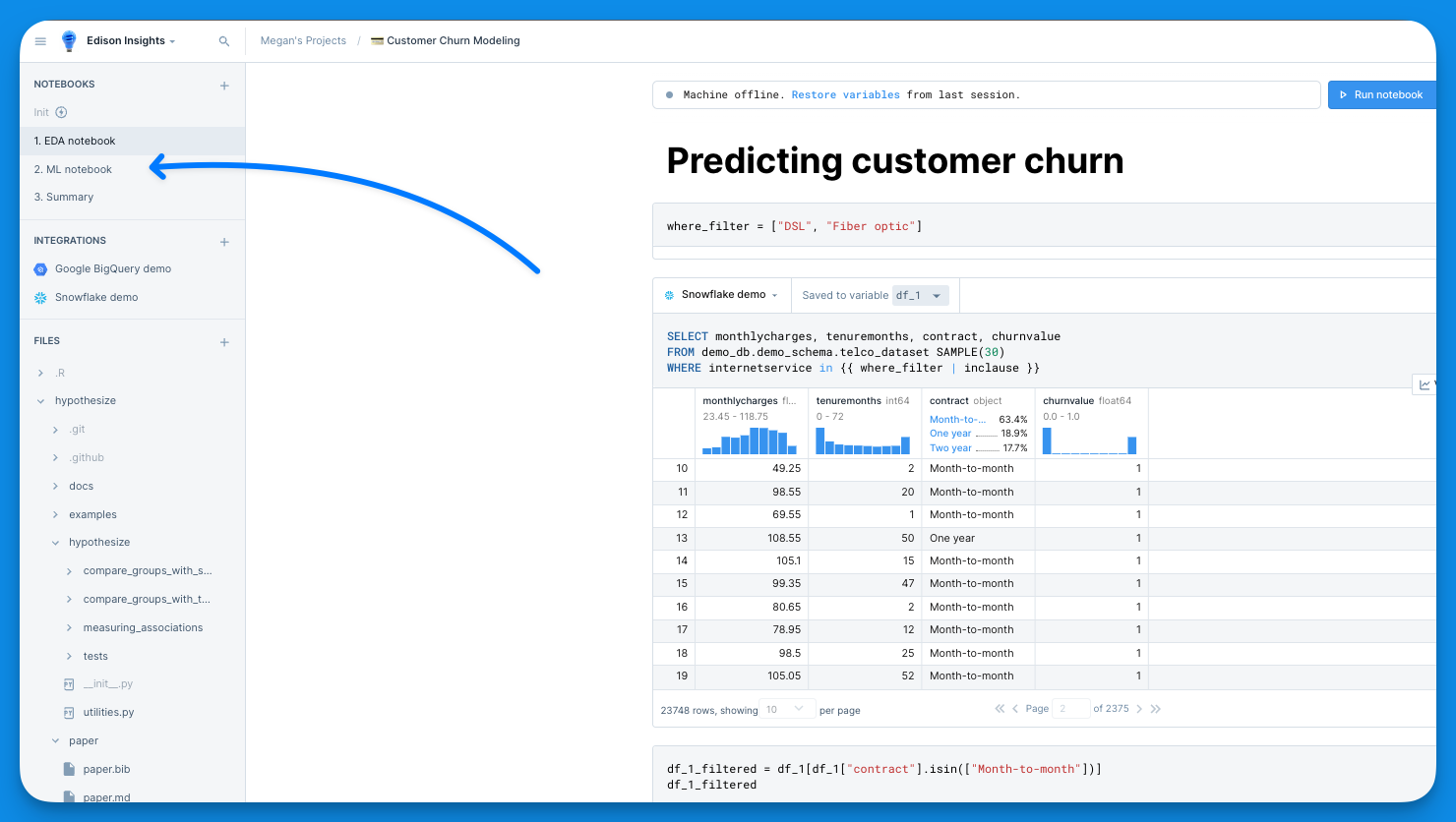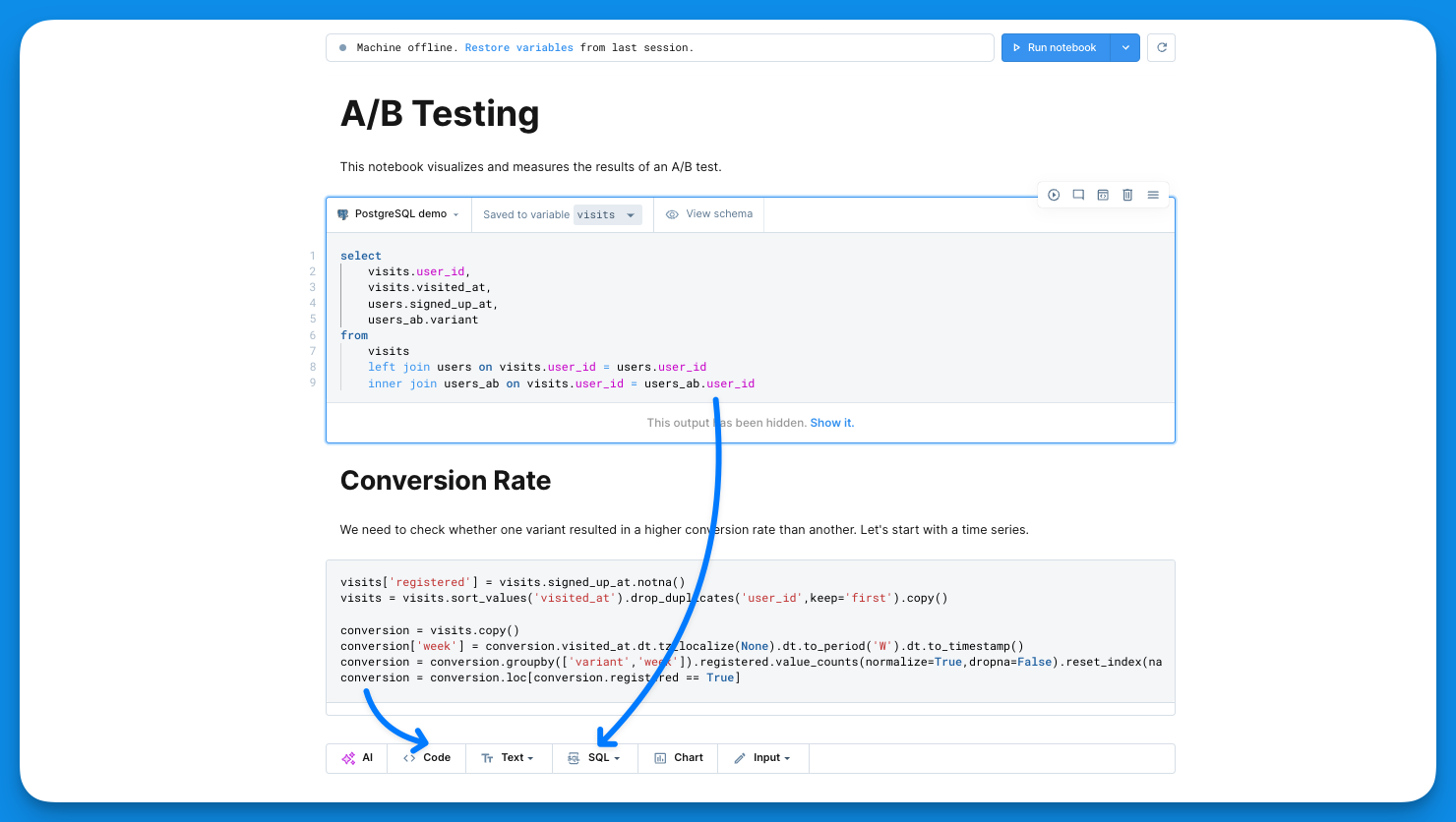Myths can be fun and harmless (George Washington and the cherry tree, anyone?). They can also be baffling (we’re not members of the Flat Earth Society at Deepnote). Either way, they can tell you a lot about what — and how — people think.
And what do the myths surrounding data notebooks tell us? That some people think this technology has stood still for the last 30-plus years.
Collaborative notebooks are built for the modern data team — and their day-to-day business challenges — but if they’re dismissed out of hand as esoteric tools for academics, data practitioners will continue to miss out on their magic.
Let’s take a look at eight of the biggest data notebook myths and why it’s time to put them to bed.
Data notebooks are only used for highly technical work
Where it came from
Data notebooks are often associated with mathematics, statistics, and physics (the first notebook was called Mathematica, after all). That’s where they started.
Why it’s wrong
Modern notebook use cases run the gamut, from straightforward data analysis to predictive modeling to building apps for business stakeholders.
Example: Deepnote customers use our notebooks to report on marketing campaign performance, develop machine learning models to detect fraud, and everything in between. Why? Because modern notebooks combine the best of both worlds: a lower barrier to entry and a high ceiling for what you can do with them.
Data notebooks are only built for data scientists
Where it came from
Data scientists were early adopters of notebooks, and they continue to find them incredibly useful for running queries, writing code, visualizing datasets, and documenting the process of uncovering insights.
Why it’s wrong
Without going down the rabbit hole of what “data scientist” strictly means anymore (plenty of today’s data scientists don’t even have it in their job title), data notebooks are designed for anyone familiar with a programming or query language and who spends most of their time using it (i.e., pretty much everyone on every data team).
Example: Data exploration (EDA), historical reporting, predictive analytics, ML model development — notebooks are for data pros, period.

Data notebooks require specific hardware
Where it came from
There was a time when hardware provisioning (not to mention installation, configuration, and plenty of engineering tickets) were part and parcel of spinning up a data notebook.
Why it’s wrong
While old-school open-source notebooks still require hosting, many modern notebooks are browser-first.
Example: Every project in Deepnote runs on a machine in the cloud. This means you don't need to worry about any kind of setup. Note that all hardware options have an enabled connection to the internet and therefore keep running even if you close your browser (also see long-running jobs).
Data notebooks are difficult to set up
Where it came from
The first notebooks were built before the advent of the “modern data stack” (and long before Twitter discourse about the same). The ocean of integrations today’s IT teams have to manage didn’t exist.
Also, connecting old-school hosted notebooks to a data source is harder than it has to be (e.g., environment configuration, Python package installation, etc.) and every new team member has to start from scratch.
Why it’s wrong
But this is not a problem with modern notebooks. Between native integrations with and connections to the most popular programming languages, frameworks, and databases, connectivity isn’t an issue. It’s a simple matter of adding credentials or API keys. And once that’s done, team members given permission can share the same connections.
Example: "We'd had a lot of technical issues when trying to pair our stack with other notebooks. Deepnote was incredibly easy to set up and allows us to start new notebooks in seconds." -Becca Carter, Data Scientist & Product Analytics Lead at Gusto
Data notebooks only work for certain programming languages
Where it came from
For many people, data notebooks are synonymous with Jupyter. And Jupyter is synonymous with Julia, Python, and R (fun fact: the name “Jupyter” is a play on all those languages combined). This leads some people to believe notebooks don’t support other common programming languages.
Why it’s wrong
Modern notebooks support a diverse set of languages, from SQL to Python. More importantly, they allow you to work with both in the same space instead of having to switch between language-specific tools or glue together SQL editors with docs and decks.
Examples: Read up on on how we support both data analyst and data scientist workflows by providing both Python and SQL functionality in the same notebook.

Data notebooks are the same as BI tools
Where it came from
Between granular data visualization options and the ability to add context to data via text, some people assume data notebooks are designed only for building and sharing dashboards with written explanations.
Why it’s wrong
They can certainly be used that way, but the cornerstone of data notebooks is exploratory programming, and data storytelling is only one small part of it.
Data professionals aren’t just concerned with gathering data and shipping a product to report on it. They’re often trying to understand what the data means — to solve a problem or answer a question. That requires exploration, which can quickly become messy and time-consuming without the right tools.
Since notebooks allow users to query, code, visualize, and document in a single location (and in any order), they’re the ideal fit for rapid experimentation and insight-sharing.
Example: “[W]orking in Deepnote is like code-review and rapid prototyping at the same time, saving valuable time in the iteration cycles,” said Luca Naef, CTO at VantAI. “But as opposed to code review via GitHub, you have direct access to the runtime and program state, which makes understanding complex models much easier and leads to much more spontaneous, creative ideas."
Data notebooks are only for solo work
Where it came from
The first notebooks weren’t built with collaboration in mind. Reproducibility, version control, sharing — they all left a lot to be desired.
Why it’s wrong
Data is now a team sport. Business stakeholders, product managers, data engineers, data analysts, data scientists — you name them, they have a vested interest in accessing, understanding, and contributing to data projects.
That’s why modern notebooks are collaborative notebooks. Maybe you want to organize and centralize all of a team’s notebooks in a shared workspace. Maybe you want to communicate asynchronously with team members using in-notebook comments. Or maybe you just want to control how different team members can view, comment, code, edit, and manage notebooks (and restore previous versions). All that and more is possible with today’s data notebooks.
Example: As one notebook user in the financial services sector said: "Deepnote allowed us to gradually experiment with collaboration at little cost and slowly scale our collaborative workflows. Ultimately, it has made a huge difference for collaboration in our team — it's night and day. There's before Deepnote and after Deepnote time.”
Data notebooks aren’t a popular form of interactive computing
Where it came from
Notebooks found their footing with more niche audiences.
Why it’s wrong
Notebook usage has exploded. As of today, there are approximately 10 million Jupyter notebooks on GitHub. That’s a 4,900% increase from 2015 — and it only accounts for that single category of notebook!
Not to mention, many future data professionals are being introduced to notebooks in the classroom. With today’s students using notebooks for collaboration with teachers and classmates, it’s a safe bet they’ll take these tools with them into the workforce.
Example: “Deepnote's philosophy — that notebooks are not just for data scientists but for teams, aligns with and enables our vision of active learning,” said Vishal Goenka, founder and CEO at 2Sigma School. “Their platform supports our unique teaching strategies focused on personalization, immediate feedback, accountability, and peer engagement."
Conclusion:
Myths are nothing new — and they’re not unique to data notebooks. But in a world where every company is looking for a data-driven edge — and teams must find ways to work faster, smarter, and more collaboratively — misconceptions shouldn’t stand in the way of finding the right tool for the job.
See the truth about data notebooks yourself
Get started for free to see what you can do with a modern data notebook.